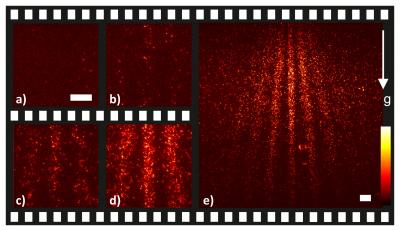A group of scientists has shot a movie, which demonstrates the build-up of a quantum interference pattern from dye molecules.
 These are selected frames of a movie showing the buildup of a quantum interference pattern from single phthalocyanine molecules.
These are selected frames of a movie showing the buildup of a quantum interference pattern from single phthalocyanine molecules.
This interference pattern is large enough to be viewed with a camera. This envisages the dual qualities of wave and particle, delocalization and locality, and determinism and randomness in a perceptive way. Thomas Juffmann’s movie ‘Seeing is believing’ was published in Nature Nanotechnology.
Physicist Richard Feynman had earlier stated that interference effects induced by matter-waves hold the secret of quantum physics. Quantum Nanophysics team led by Markus Arndt at the Vienna Center for Quantum Science and Technology and the University of Vienna is studying matter waves for novel technologies. The researchers premiered a movie, which illustrates the build-up of a quantum interference pattern from phthalocyanine particles after these dye molecules passed through a thin nanograting. Once the molecules reach the screen, the scientists captured the live images through a fluorescence microscope, which can image each molecule and locate it individually with a precision of 10 nm, which is below 1/60 of the wavelength of the imaging light and below a thousandth of the thickness of a human hair.
In these studies, van der Waals forces between the gratings and molecules presented a problem. These forces occur because of quantum vacillations and impact the interference pattern. The scientists used 10-nm gratings to minimize this van der Waals interaction. Nanotechnology team around Ori Cheshnovski at the Tel Aviv University has developed these thin gratings. The team utilized a focused ion beam to incise the slits into a free-standing membrane.
The experimental studies may be applied to phthalocyanine heavier derivatives, which were developed by Marcel Mayor and his team at the University of Basel. The micro- and nanotechnologies to create, diffract and detect molecular beams will prove vital for applying quantum interference experiments to intricate molecules and atom interferometry. The experiments demonstrate the nature of quantum diffraction patterns, which remain on the screen for a long time and can be viewed with the naked eye. The experimental studies make the duality of quantum physics conspicuous and tangible.